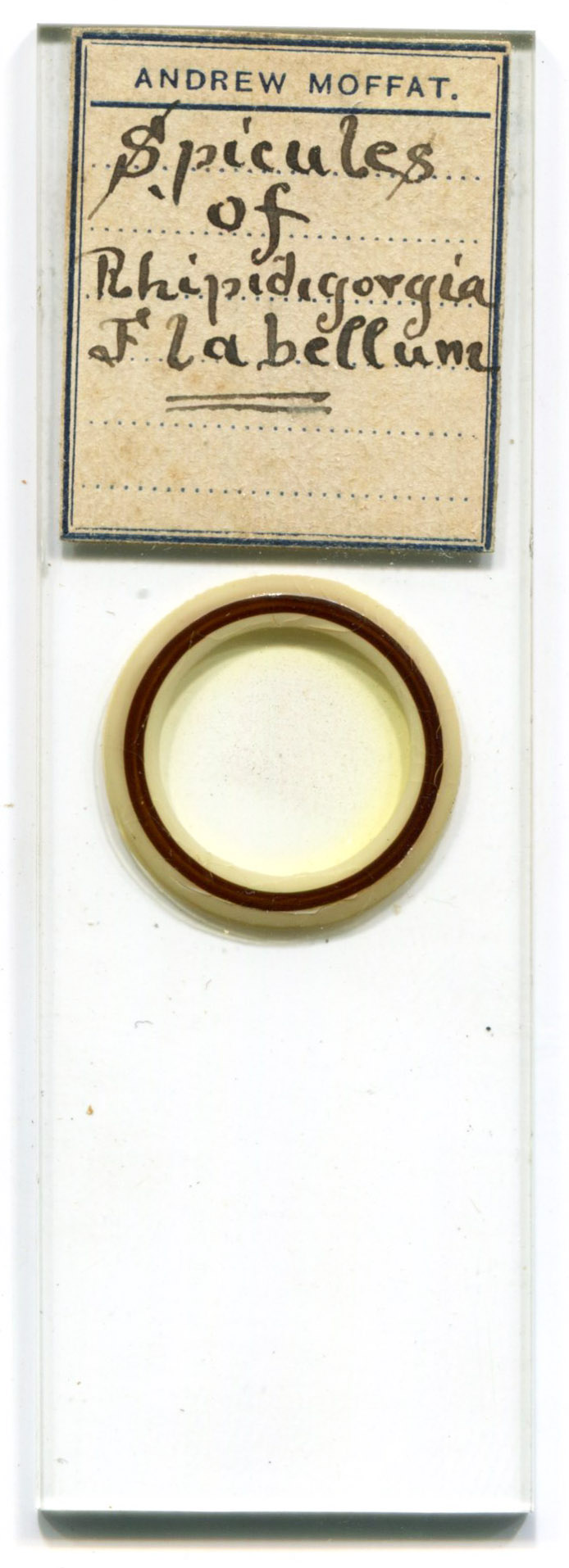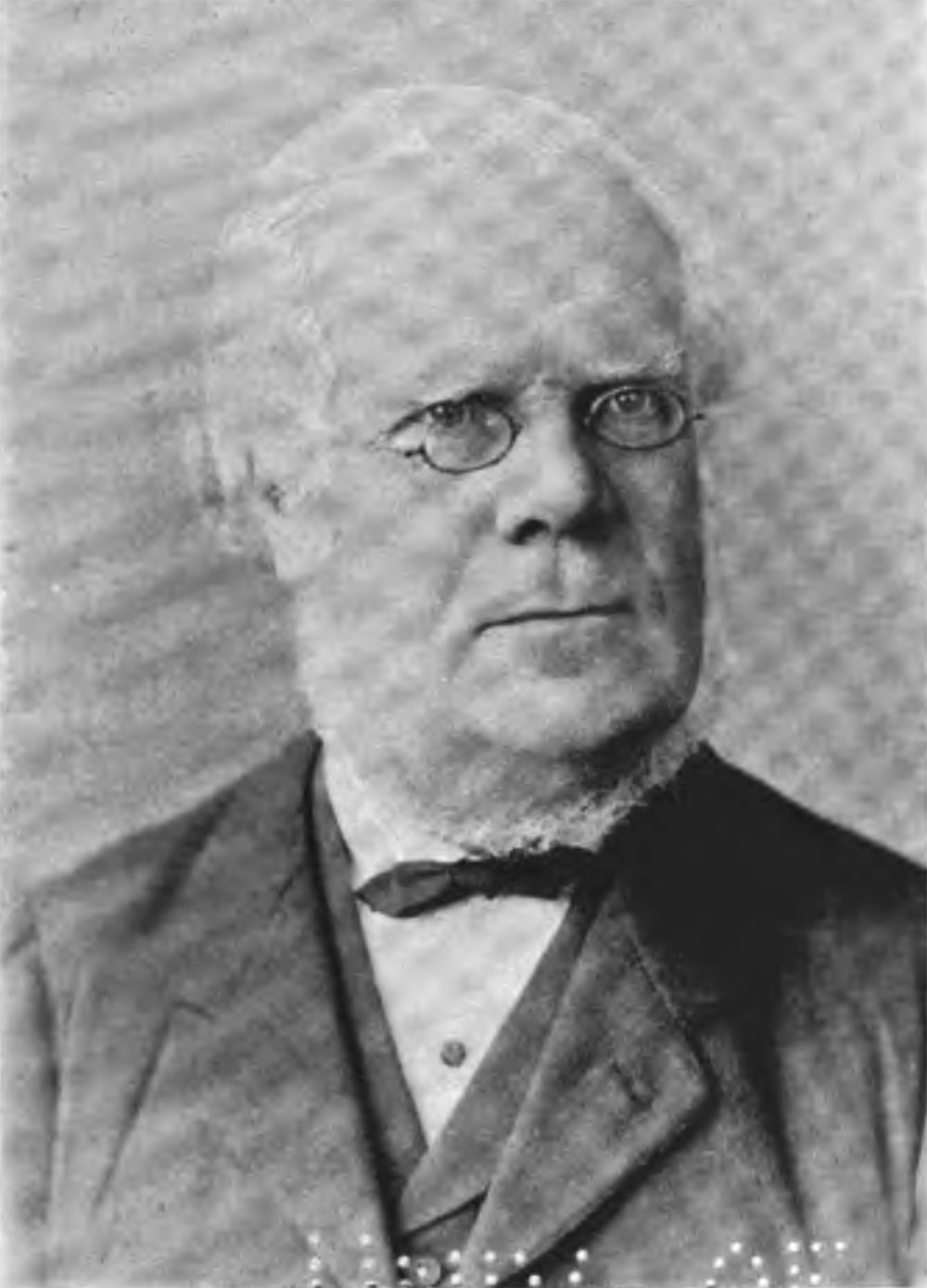
Figure 1. ca. 1880s microscope slide of Gorgonia spicules, prepared by Andrew Moffat.
Andrew Moffat, 1832 - 1896
by Brian Stevenson
last updated September, 2019
Andrew Moffat was a long-time member of the Edinburgh Naturalists' Field Club, and served as the society’s Secretary from 1873 until 1894. His primary interests were botanical, although a colleague noted Moffat’s proficiency at “palaeontology, entomology, and practical microscopy”. He was skilled at mounting specimens for microscopical examination. Moffat is recorded as having led classes for the Field Club on topics such as “the mounting of animal tissues in glycerine-and-water”.
Known examples of Moffat’s slides show neat construction, with type-set labels and attractive, clear handwriting (Figure 1). His mounts are generally scarce. I did not find evidence of Moffat advertising to exchange slides with other microscopists, so surviving mounts probably came from close colleagues, or breaking up of his personal collection.

Figure 1.
ca. 1880s microscope slide of Gorgonia spicules, prepared by Andrew Moffat.
The life of Andrew Moffat was nicely summarized by his colleague John Lindsay, in a memorial that was published in The Transactions of the Edinburgh Field Naturalists' and Microscopical Society after Moffat’s death. It is reproduced here, with a few additions and rearrangements:
“Andrew Moffat was born at Leith on the 20th February 1832. The first school he attended was one well known in Leith at that time and for years afterwards as ‘Walker's School’; but he soon quitted it for Bathgate Academy. There he made rapid progress, leaving the Academy at the age of fourteen as mathematical dux of the school. He next proceeded to the Royal High School, Edinburgh, then under the rectorship of the well-known Dr. Leonard Schmitz, where he remained two years, matriculating at Edinburgh University in 1848, at the early age of sixteen. During his University course he attended the classes of Humanity and of Greek, taught respectively by Professor Pillans and Professor Dunbar; the class of Logic and Metaphysics, taught by Sir William Hamilton; that of Mathematics, by Professor Philip Kelland; of Moral Philosophy, by Professor John Wilson (‘Christopher North’); and of Natural Philosophy, by Professor James David Forbes, afterwards Principal of St Andrews University. These were men, most of them, of European fame as teachers and scholars, and there is evidence to prove that our young student profited largely from their prelections. As showing his early taste, also, for music, which was all his life so much of a solace and a delight to him, it may be mentioned that amongst his class tickets is one showing that during the university session of 1849-50 he attended the lectures of Professor Donaldson on the Theory of Music.
It being the custom at that time for students not to seek' graduation, Andrew Moffat, now twenty years of age, left the University without a degree, but with a well-stocked mind as the result of this careful training, and he proceeded at once to open a school in his native town. In this sphere of duty the next fifteen years of his life were spent, his school becoming somewhat famous in the town, until in 1867 he accepted the post of Head-Master of South Leith Parochial School. When the Education Act came into force, and Board Schools were gradually erected, this parochial school ceased to exist, and in 1878 Mr. Moffat secured the appointment of Arithmetical Master in George Watson's Ladies' College. Here the rest of his life-work as a teacher was accomplished, and in this favourite branch of education in which he had gained his first laurels as the dux of Bathgate Academy more than thirty years before”.
(Andrew Moffat married Lily Milne on December 25, 1857. They had two children, Helen and Andrew, but Lily died around the time of Andrew Jr.’s birth in 1860. Our microscopist remarried in 1864, to Margaret Herbert. They had one child, Jessie, in 1865, then Margaret died. Andrew married for a third time in 1868, to Marion Lowe, and that pair had two children, Euphemia and George.)
“But it was not only as an instructor of youth in the dayschool that Mr. Moffat put forth his energies: during many years he laboured in connection with Sunday-school and Bible class and mission work, in all of which he was most successful. For twenty years, also, he was an office - bearer in Great Junction Street U.P. Church, Leith, and was presented with a piece of silver-plate and a purse of sovereigns in acknowledgment of his services as session-clerk to that congregation.
It was, however, as the Secretary and Treasurer of this Society that most of us knew Mr. Moffat best. The Society was founded as the Edinburgh Naturalists' Field Club on June 2, 1869, and between that time and December 9, 1873, when Mr. Moffat was appointed its Secretary, no fewer than six secretaries had already been in office. Mr. Moffat resigned the united offices of Secretary and Treasurer on October 26, 1894, so that for the long space of nearly twenty-one years he had performed these duties for the Society, and was thus intimately acquainted with its affairs during all that time. He had been a member of the Society for about a month only when he was asked to undertake these services: his membership and secretaryship were therefore of almost equal duration.
Of sterling probity, Mr. Moffat was also methodical and painstaking in every duty he performed. He was a born leader, and generally succeeded in infusing some of his own enthusiasm into those who rallied round him. His attainments as a field-botanist are known to all the members of the Society. He had a wide and an accurate acquaintance with our native plants, and there were few localities in Mid-Lothian into which he had not penetrated in pursuit of his favourite study, though often going much farther afield. The herbarium he has left is very complete and extensive; and a beautiful collection of mosses attests his knowledge of this department of botany.
While Mr. Moffat did much to increase the usefulness of the Society, there can be no doubt that he too was a gainer from his close connection with it. His prominent position in it for so many years gave an impetus to his own leanings towards the study of Natural History, and he spared no efforts to gain some proficiency in such branches as palaeontology, entomology, and practical microscopy. Amongst the 3000 volumes which comprise the library he formed, there are many bearing on his favourite pursuits, as well as works in classical and general literature. In one of the press notices of Mr. Moffat which appeared at the time of his death, there is a very pleasing reference to a scene which was by no means of unfrequent occurrence in the Ladies' College at George Square. The arithmetical master is there depicted as "off duty," and surrounded by a bevy of fair maidens, to whom he is giving the names and pointing out the characteristic features of the wild-flowers held in his hand, and which had been brought by the young ladies themselves in order that they might enjoy this extra lesson. With recollections of happy summer hours spent with him in field and wood and by the sea-shore, it is in this connection that many of us would like best to remember our late respected Secretary.
When Mr. Moffat resigned the secretaryship of the Society two years ago, the Council, besides electing him an Honorary Member, resolved that his portrait, with that of Dr. Sprague - to whom also the Society owes much - should be placed in the forefront of the current volume of the Society's 'Transactions,' and this accordingly has been done. Future members may thus gain some idea of the appearance of him whose memory we now desire, by this memorial sketch, to perpetuate. But his commanding figure and his genial presence, which could be sufficiently severe on occasion, will not be soon forgot by any of those who either worked alongside of him or came frequently in contact with him.
The announcement made by the President at the meeting of the Society on October 28, 1896, that our late Secretary, Mr. Moffat, had died on the previous evening, came with the shock of a sad surprise to all the members. Though it was known to many of us that he had been in poor health during the summer, yet he seemed to have regained in autumn his wonted vigour, and indeed spoke of himself as feeling better than he had done for years. His school duties had been resumed at the beginning of the session, in October, and all seemed to be going well with him. But on Sunday, October 25, he again began to complain of feeling ill; was worse on the next day, when the family doctor was summoned; and passed away peacefully on the evening of the following day, Tuesday, the 27th. The immediate cause of death was the rupture of a blood-vessel in the region of the liver. On Friday, October 30, he was laid to rest in Warriston Cemetery. At the funeral the Society was represented by Dr. Davies, the President, and by Dr. Watson, Past President.
Mr. Moffat is survived by his wife, two sons, and two daughters”.

Figure 2.
Andrew Moffat, from a photograph that was included in his 1896 memoriam.
Resources
Baptism record of Andrew Moffat (1832) North Leith parish records, accessed through ancestry.com
Lindsay, John (1896) In memoriam: Andrew Moffat, Transactions of the Edinburgh Field Naturalists & Microscopical Society Vol. 3, pages 214-217
Marriage record of Andrew Moffat and Lily Milne (1857) Leith parish records, accessed through ancestry.com
Marriage record of Andrew Moffat and Margaret Herbert (1864) Yetholm parish records, accessed through ancestry.com
Marriage record of Andrew Moffat and Marion Lowe (1868) Edinburgh parish records, accessed through ancestry.com
Moffat, Andrew (1887) Lists of the less common plants gathered at the excursions during 1886 and 1887 with localities, Transactions of the Edinburgh Field Naturalists & Microscopical Society Vol. 2, pages 79-80
Scotland census and other records, accessed through ancestry.com
Transactions of the Edinburgh Field Naturalists & Microscopical Society (1887) Vol. 2, page 88